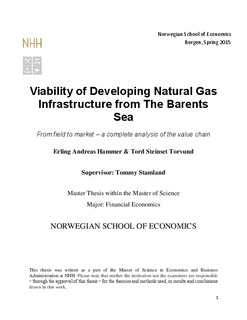Viability of developing natural gas infrastructure from the Barents sea : from field to market – a complete analysis of the value chain
Master thesis
Permanent lenke
http://hdl.handle.net/11250/300264Utgivelsesdato
2015Metadata
Vis full innførselSamlinger
- Master Thesis [4372]
Sammendrag
This thesis assesses whether it is profitable to build a natural gas infrastructure solution in the Barents
Sea, under reasonable assumptions about costs and revenues. In order to answer this question we have
looked at the resource base in the Barents Sea and the probability of new discoveries, how the global
market for natural gas will develop, at what cost the oil and gas companies will be able to recover the
resources, and what type of infrastructure that suits the region best and how it could be financed.
Our findings indicate that a natural gas pipeline would be a profitable solution, while other solutions are
either not technically viable or not profitable. The proven resource base alone is not sufficient to justify
a pipeline development, but the likelihood of new discoveries is high if exploration activity is increased.
We found that exploration has been limited as a consequence of lacking infrastructure, meaning that
there is a timing paradox concerning development of the region. If there is no infrastructure solution in
place, there will not be enough exploration, and if there is not enough exploration, there will not be
enough discoveries to justify the infrastructure development. We have found that a project finance approach could have solved the timing paradox, if oil and gas companies were willing to contractually commit to pay for transportation rights beyond what their current discoveries will justify. As a project finance approach allows for high level of risk allocation between project participants, it is possible to divide project risk within the capital structure so that the infrastructure investment offers an attractive opportunity for various investors. We have found that a pipeline could be financed by dividing the risk between debt holders, infrastructure funds and oil and gas companies, so that all parties are able to achieve a risk-reward profile that match their preferences. However, we found that oil and gas companies are not willing to make these kinds of contractual commitments. This means that the pipeline project will have to carry more risk, making high leverage, as suggested in our project finance model, challenging. To solve the timing paradox we thus conclude that government intervention is necessary. We find that state financing of the infrastructure is a better solution then further incentivizing exploration. State financing might be viewed as selective business support and is consequently politically difficult.
